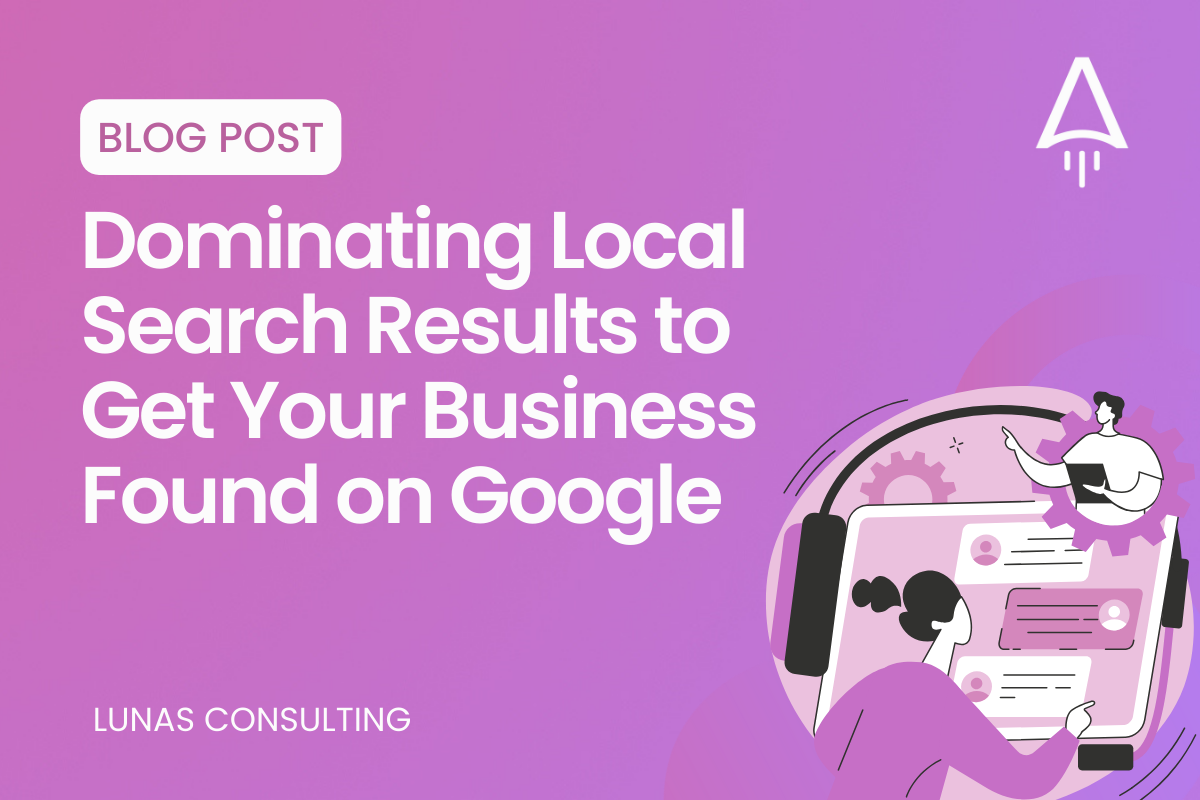Dominating Local Search Results to Get Your Business Found on Google
From Google Business Profile optimization to advanced local SEO techniques, learn how to dominate local search results and drive foot traffic.
From Google Business Profile optimization to advanced local SEO techniques, learn how to dominate local search results and drive foot traffic.

Nearly half of all Google searches seek local information, yet many local businesses remain invisible in these crucial moments of customer intent. This gap between customer searches and business visibility represents a massive missed opportunity.
The challenge of competing in local markets without proper search optimization intensifies as more businesses recognize local SEO's importance. Generic SEO tactics fail to capture location-specific searches. National competitors with local landing pages crowd results. Mobile searches demanding immediate answers bypass businesses lacking optimization.
This guide provides actionable strategies for local search dominance. Through systematic optimization techniques and proven tactics, you'll learn to appear prominently when nearby customers search for your services. Let's explore how local search visibility transforms into real customer visits and revenue growth.
Local search encompasses all online queries with geographic intent, whether explicit ("pizza near me") or implicit (Google inferring location from user context). This search behavior fundamentally changes how customers discover and choose local businesses.

Consumer behavior in local discovery reveals urgent intent. Unlike general searches where users research leisurely, local searches often precede immediate action. Someone searching "emergency plumber" or "open restaurants nearby" needs solutions now, making visibility in these moments critical for business success.
Revenue impact of local search visibility proves substantial for businesses serving geographic areas. Local search drives foot traffic, phone calls, and online conversions. Businesses appearing in Google's local pack (top three map results) capture the majority of clicks and subsequent business from local searches.
Local search particularly influences:
Understanding these behaviors helps prioritize optimization efforts where they'll generate maximum impact.
Local SEO differs from traditional SEO through geographic relevance factors. While traditional SEO focuses on topical authority, local SEO combines relevance with proximity and prominence to determine rankings.
Core ranking factors for local search include:
Google's local algorithm components weight these factors differently based on search type. "Near me" searches heavily favor proximity, while specific service searches ("estate planning attorney") emphasize relevance and prominence.
Mobile-first local search considerations reflect changing search behaviors. Mobile searches more frequently include local intent and expect immediate results. Page speed, click-to-call functionality, and mobile-responsive design become critical for capturing these micro-moments of intent.
Google Business Profile optimization remains the foundation of local search success. This free tool directly influences how businesses appear in search results and maps.
Business information accuracy prevents customer frustration while improving rankings. Ensure every detail is correct:
Category selection optimization significantly impacts visibility. Choose the most specific primary category that accurately describes your main business. Add secondary categories for additional services, but avoid category stuffing that dilutes relevance.

Service area definition helps businesses without storefronts or those serving specific regions. Accurately define where you travel to serve customers. Be realistic—claiming overly broad areas reduces relevance for actual service locations.
High-quality business photos dramatically improve engagement and clicks. Google reports businesses with photos receive significantly more requests for directions and website clicks than those without.
Essential photo categories include:
Regular photo updates signal active business management. Add new photos monthly, showcasing seasonal changes, new products, or recent projects. Fresh visual content improves engagement while demonstrating ongoing business operation.
Local keyword research identifies how nearby customers search for your services. This differs from general keyword research by incorporating geographic modifiers and local intent signals.
Local keyword identification strategies start with brainstorming service-location combinations. Consider variations like:
Location-based search intent analysis reveals whether searches seek immediate solutions or research information. "Emergency dentist near me" shows urgent need while "dental implant cost in [city]" indicates research phase. Tailor content to match intent stages.
Competitor keyword analysis uncovers successful local targeting strategies. Examine which location pages competitors create, how they structure URLs, and which local modifiers they target. This research reveals gaps and opportunities in local markets.
Long-tail local keyword opportunities often face less competition while attracting highly qualified traffic. "Pet-friendly restaurants downtown [city]" or "24-hour iPhone repair [neighborhood]" capture specific needs with clear local intent.
A tip from us: Use Google's autocomplete feature with local modifiers to discover how people actually search in your area. Type your service followed by your city name and note the suggestions—these reflect real search behaviors.
Website optimization for local search requires specific on-page elements that signal geographic relevance to search engines.
Location page optimization for single-location businesses involves creating locally-focused content throughout the site. Multi-location businesses need individual pages for each location with unique, valuable content—not just address swaps in template pages.

NAP consistency across websites reinforces local signals. Your business Name, Address, and Phone number should appear identically wherever mentioned. Include this information in footers, contact pages, and about sections. Even minor variations confuse search engines.
Schema markup implementation provides structured data that helps search engines understand your local business information. LocalBusiness schema includes:
Local content creation strategies develop pages targeting geographic searches. Create area guides, local resource pages, or community involvement highlights. This content naturally incorporates local keywords while providing genuine value to residents.
Citations—mentions of your business name, address, and phone number across the web—build local search authority. Quality citations from relevant sources strengthen local rankings.
Primary citation source identification starts with major platforms:
NAP consistency maintenance across citations requires meticulous attention. Spreadsheet tracking helps ensure identical information everywhere. Even abbreviation differences ("St." vs "Street") can dilute citation power.
Industry-specific directory submissions target audiences already seeking your services. Legal directories for law firms, health platforms for medical practices, or home service aggregators for contractors provide relevant citations plus potential customers.
Quality versus quantity in citation building favors selective approaches. Fifty citations from relevant, authoritative sources outperform hundreds from low-quality directories. Focus on citations that actual customers might use.
Reviews significantly influence local search rankings and customer decisions. Active review management improves both visibility and conversion rates.
Review generation strategies must feel natural rather than forced. Successful approaches include:
Response protocols for all feedback demonstrate engagement. Thank positive reviewers specifically, mentioning details they appreciated. For negative reviews, acknowledge concerns professionally and offer resolution paths. Quick responses show attentive business management.
Review platform diversification prevents over-reliance on single sources. While Google Reviews matter most for search, maintain presence on industry-relevant platforms. Spread review requests across platforms for balanced profiles.
Reputation monitoring systems alert you to new reviews requiring attention. Google Alerts, reputation management tools, or simple calendar reminders ensure timely responses that maximize review benefits.
Local content strategies build topical authority while naturally incorporating geographic keywords. This content serves residents while strengthening local search signals.

Local content strategy development identifies topics combining expertise with community interest:
Community event coverage provides timely, relevant content while demonstrating local involvement. Preview upcoming events, share real-time coverage, and post event recaps with photos. This content attracts local links and social shares.
Local partnership highlighting showcases community connections. Feature other local businesses, spotlight charity work, or document collaborative projects. These posts often earn reciprocal promotion and valuable local links.
Neighborhood-focused blog content helps capture hyperlocal searches. Create guides to specific areas you serve, highlight local attractions, or share insider knowledge only locals would know. This authentic local content differentiates from generic, outsourced content.
Technical optimization ensures search engines can properly crawl, index, and understand your local relevance signals.
Website speed optimization matters more for local searches often conducted on mobile devices with varying connection speeds. Compress images, minimize code, leverage browser caching, and consider CDN usage. Every second of load time impacts bounce rates and rankings.
Mobile responsiveness requirements go beyond basic functionality. Local searchers need easy access to:
Local structured data implementation extends beyond basic schema. Include:
Site architecture for multi-location businesses requires careful planning. Create clear URL structures (/locations/city-name/), implement proper canonical tags, and ensure each location page provides unique value beyond address differences.
A tip from us: Test your website's mobile experience by searching for your business on your phone and attempting common actions like calling or getting directions. Friction points you experience likely frustrate customers too.
Local search extends beyond Google to numerous platforms where customers discover businesses. Comprehensive optimization captures visibility across all relevant channels.

Apple Maps Connect optimization reaches iOS users who default to Apple's mapping service. Claim and optimize listings with complete information, photos, and regular updates. Apple Maps particularly influences mobile navigation decisions.
Bing Places for Business setup captures Microsoft ecosystem users. While smaller than Google, Bing powers various services including Cortana, making optimization worthwhile for comprehensive coverage.
Social media location optimization ensures consistent geographic signals. Tag business locations in posts, use location-based hashtags, and enable location features on all platforms. Social signals increasingly influence local search visibility.
Voice search optimization strategies adapt content for conversational queries. Natural language phrases, question-based content, and featured snippet optimization help capture voice searches that frequently include local intent.
Measurement transforms optimization efforts from guesswork into strategic improvement. Local search metrics differ from traditional SEO in focusing on geographic performance.
Key performance indicators tracking for local search:
Google Analytics local insights reveal geographic traffic patterns. Analyze which locations drive traffic, conversion rates by geography, and local landing page performance. This data guides content creation and optimization priorities.
Ranking position monitoring requires location-specific tracking. Rankings vary dramatically by searcher location, making traditional rank tracking insufficient. Use tools that check rankings from specific locations or zip codes.
Conversion attribution methods connect local visibility to revenue. Implement call tracking, form source tracking, and in-store survey data to understand which local search efforts drive real business results.
Understanding common pitfalls helps avoid wasted effort and potential penalties.
Inconsistent business information across platforms confuses both search engines and customers. Maintain a master document with official business details and audit all platforms quarterly for consistency.
Neglecting mobile optimization particularly damages local search performance. With most local searches occurring on mobile devices, poor mobile experiences directly reduce customer acquisition.
Ignoring negative reviews allows problems to compound. Even unfair negative reviews deserve professional responses demonstrating how you handle criticism. Silence appears as indifference to future customers reading reviews.
Keyword stuffing in local content creates unnatural, unhelpful pages. Instead of repeating "plumber in [city]" endlessly, create valuable content that naturally includes location context.
Long-term local search success requires systematic approaches that evolve with algorithm changes and market dynamics.
Long-term optimization planning creates roadmaps beyond quick wins:
Resource allocation strategies balance effort across priorities:
Team training and development ensures consistent execution. Train staff on review response protocols, photo contribution guidelines, and basic local SEO principles. Distributed effort multiplies impact.

Continuous improvement processes adapt strategies based on results. Monthly performance reviews, quarterly strategy adjustments, and annual comprehensive audits keep optimization efforts current and effective.
Local search strategies that drive customers require systematic optimization across multiple channels. Success comes from consistent execution of fundamentals rather than searching for secret tactics.
Start with Google Business Profile optimization as your foundation. Ensure accurate information, maintain regular updates, and actively manage reviews. Build from this base through website optimization, citation development, and local content creation.
Remember that local SEO serves real customers seeking immediate solutions. Every optimization effort should improve user experience while strengthening search visibility. This customer-first approach naturally aligns with search engine goals, creating sustainable competitive advantages.
Interested in improving your skills and learning more about business operations to generate and convert leads? Check out the following articles:
Essential Online Presence Tools Every Business Owner Should Use in 2025
Why Small Businesses Need a Strong Online Presence to Survive and Thrive
How Your Online Presence Functions as Your Most Powerful Business Card
Building a Loyal Online Following Through Strategic Social Media Consistency
How Social Media Transforms Your Digital Strategy and Online Business Growth
10 Time-Saving Strategies for Effective Business Updates Across Social Media Platforms
We have a lot more for you. Click the button below to sign up and get notified when we release more content!
View more